 Global Gold Highs Global Gold Highs
Adam Hamilton
Archives
Oct 14, 2005
Earlier this week gold closed
over $475 in US dollar terms and came within spitting distance
of €400 in euros. These stunning levels are far above the
$256 and €277 bear-market lows of early 2001. This gold
bull has come a long way!
While gold's fresh new bull-to-date
dollar highs are certainly exciting for American contrarians,
the new global gold highs being achieving in the euro and other
currencies are far more important. Gold's amazing dollar-independent
strength since June or so really supports the thesis that this
gold bull is transitioning into Stage Two. A few weeks ago I
discussed the accumulating evidence for Stage
Two as well as defined it.
"Stage One is primarily
currency-devaluation driven. This is what we have witnessed in
recent years as gold typically only gained significant ground
when the US dollar, the world's reserve currency, was losing
value. Stage Two is driven by global investment demand which
makes gold decouple from the dominant currency and rise on its
own fundamental merits in all currencies simultaneously."
Stage Two is so important for
investors because the gains that are likely to be reaped in this
phase of gold's long-term bull-market
parabola should should utterly dwarf those Stage One gains
with which we have been blessed so far. Identifying whether we
now sojourn in the early stages of Stage Two or still linger
in Stage One is also very important to speculators as trading
strategies vary significantly across the different stages.
In Stage One gold's primary
driver is the devaluation in the dominant currency. Because of
this, gold has been very successfully
traded in recent years based on the flowing and ebbing of
the dollar
bear. But since gold decouples from the dollar in Stage Two,
all the dollar-based gold trading strategies are doomed to fail
sooner or later.
The ability to discern when
probabilities favor optimal buying and selling times depends
on our relative position within gold's three-stage bull. Since
Stage Two is defined as gold rising in all currencies simultaneously,
we can look at gold charts from dominant currencies around the
world to see if this is really happening today. This is a simple
exercise in theory, but finding the necessary comparable charts
is difficult.
If one searches long enough,
gold charts in any currency can be dredged up off the internet.
But unfortunately they are not readily comparable. They run for
widely differing periods of time, their scales vary considerably,
their units of measurement are often local (like pricing gold
in grams instead of ounces), and they are heavily biased towards
the short term. Charts of the last few months are vastly more
prevalent than secular charts.
For quite some time I have
looked for comparable secular global gold charts that are updated
periodically. After failing in this quest, I decided to build
such charts internally so we had them for reference. These charts,
especially when all are considered together and compared and
contrasted, offer a superior perspective on Stage Two. I'd like
to update these charts several times a year or so over the coming
years to monitor gold's global progress.
For this inaugural iteration,
I chose ten currencies in which to chart this gold bull to date.
I tried to include all the major and important world currencies
as well as a couple less important regional ones so all continents
are represented. We'll start in North America, swing through
South America, head to Europe, visit the hugely important Asian
giants, stop over down under in Australia, and conclude our journey
in Africa.
All of these charts share a
common format for easy comparability. On the left axis, the dollar
cost of a single unit of each foreign currency is charted in
red. This shows the relative strength (rising) or weakness (falling)
of each currency relative to the dollar over the course of this
gold bull. Overlaid on top of this and slaved to the right axis
are the foreign gold price, key moving averages, and Bollinger
Bands.
To keep these charts comparable,
all gold prices are quoted in currency per troy ounce even if
not local custom. For example, in Japan gold is typically quoted
in yen per gram but this is not comparable. In addition all exchange
rates are quoted in the dollar cost of one unit of local currency
even if not customary. For instance, in Japanese yen the exchange
rate is typically quoted as yen per dollar, like ¥113, instead
of dollar per yen, like $0.008827, for obvious reasons.
If these customary reverse
rates that are easier to quote because they are not fractional
are charted, the relative strength and weakness of the dollar
is inverted. I wanted a rising red line on any of these charts,
regardless of custom, to show a local currency gaining strength
against the US dollar. As such, a given forex rate, especially
if fractional, might be the inverse from what is reported on
the news each day.
Technically, on each chart
the secular lows and highs in both gold and exchange rates are
marked with arrowheads and bull-to-date gains/losses are noted.
Major long-term technical trendlines are also rendered to help
highlight the prevailing secular trends. Technical analysis works
the same all over the world regardless of the nationality of
the investment being studied.
The six major bull-to-date
highs in dollar gold are also noted in each chart. Green numbers
represent a new bull-to-date high while red numbers mark a time
when US dollar gold made a new high but local-currency gold did
not. This helps us better understand how our various major US
gold highs looked to foreign investors in their home currency
so far in this bull to date.
So is gold finally rising in
all currencies simultaneously? Yes, for the most part. It is
rising in all major currencies today and making new bull-to-date
highs in the most important world currencies. But in some less
important currencies that have seen a lot of chaotic turmoil
in the past five years gold still remains far off new bull-to-date
highs. If you are a gold investor the following global gold journey
should prove fascinating.
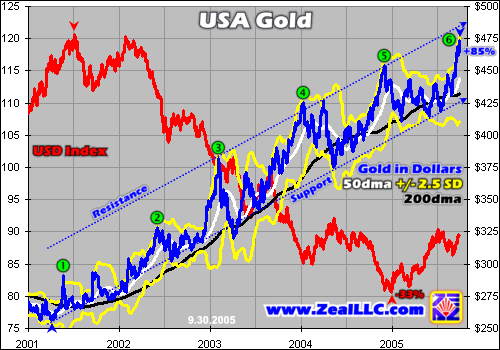
Love it or hate it, dollar
gold is still the standard by which this gold bull is measured.
Not only is the dollar still the dominant global currency even
though its hegemony is waning, but the global gold market is
priced in dollars. No matter where on earth gold is mined it
is sold for US dollars or else the local-currency equivalent
of the prevailing US dollar price per ounce. Maybe gold will
be universally priced in Chinese yuan someday, but for now the
dollar remains king in the gold world.
For the red dollar "exchange
rate" above, we are using the US Dollar Index. This index
averages the exchange rates between the US dollar and six of
the world's major currencies including the euro, yen, British
pound, and Canadian dollar. These countries constitute the bulk
of international trade with the US. As this index shows, the
international value of the dollar has fallen by a third since
2001 during the dollar's bear.
During this time dollar gold
has powered higher in a relentless secular bull. It is up 85%
bull to date and has carved a remarkably well-defined uptrend
that is rendered above. While not quite there yet, dollar gold
is certainly nearing its upper resistance line again that has
repelled it into major corrections several prior times in this
bull to date. Dollar gold may very well correct and regroup once
it challenges this resistance line again.
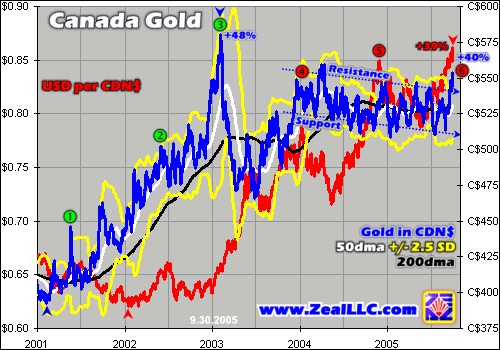
In Canada, like most of the
rest of the world, this gold bull has not been as strong yet
since a big part of dollar-gold gains were offset by gains in
the local currency. The Canadian dollar is up 39% since its low
in early 2002, which has clipped gold's bull-to-date gains to
40% or so. In early 2003 Canadian gold rocketed higher to a 48%
gain before the Canadian dollar really started rising, but this
C$581 level has yet to be exceeded.
While finally breaking out
today, for almost two years now Canadian dollar gold has been
mired in a tight and gradually downsloping trading range. Naturally
this has sapped the enthusiasm of Canadian gold investors somewhat,
but Canadian miners have still thrived tremendously in this gold
bull. To get gold in the financial news in a big way in Canada,
it will have to exceed C$600 or so and trade to new bull-to-date
highs.
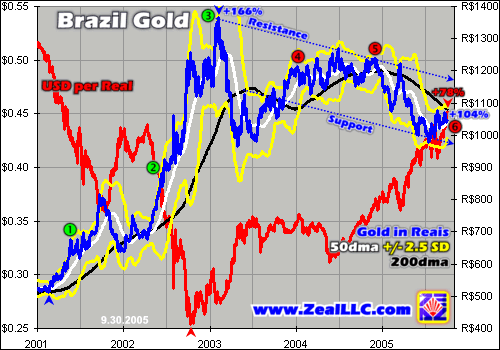
While South America doesn't
even appear on the global radar in the major-currency category,
I did still want the continent represented in our global gold
survey. I chose Brazil not because it has a strong currency,
but because there are no strong currencies in South America and
Brazil dominates the continent's economy. As the regional leader,
the Brazilian real is probably the most important gold measure
in South America.
Like the Canadian dollar, the
highest bull-to-date Brazil gold price occurred in early 2003,
a magnificent 166% gain. While the real has been growing consistently
stronger against the dollar since then and eroding gold's gains,
Brazil gold is still up 104% bull-to-date today, considerably
better than even US dollar gold. In order to break out Brazil
gold must exceed R$1200 or so. To get Brazilians really excited
we will need to see new bull-to-date highs well above the R$1400
last challenged in early 2003.
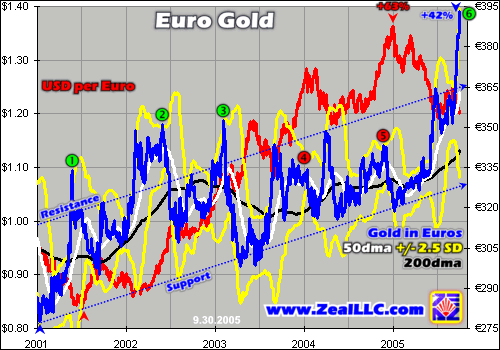
Of all these non-US-dollar
gold charts, euro gold is probably the most universally known
and followed. I have written a lot about it and believe the euro gold breakout
of recent months is tremendously important. While euro gold struggled
with €350 for many years, it has now broken decisively
above these chains and is even challenging €400. This is
really starting to intrigue European investors and ought to entice
a lot more capital into the gold market worldwide.
And the euro itself, though
it has corrected recently as the red line shows, still remains
very strong relative to the dollar from a secular perspective.
While the euro is also pure fiat and is not superior to the dollar
in a sound-money sense, Europe seems to have far less debt and
inflation problems than the States so the euro should continue
appreciating. Some Middle Eastern OPEC countries are even discussing
pricing oil in euros.
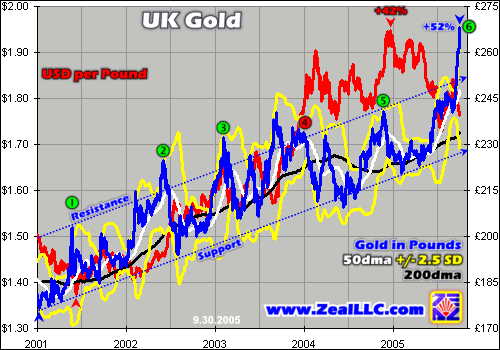
The UK is not only a major
European economic power, but it is hugely important in the gold
world. For centuries London has been the center of the world
gold trade and this is unlikely to change in the foreseeable
future. Despite the pound strengthening against the US dollar,
the UK gold price is also in a powerful secular bull market that
has broken out to fantastic new bull-to-date highs recently.
The UK gold uptrend rendered
above is well-defined with its 200-day moving average running
parallel. Gold will probably correct to at least £250 or
so, at its long-term resistance line, before making an assault
on new highs. With UK gold already much higher than it has been
bull to date, British investors are really starting to pay attention.
And the goofy Bank
of England managers, who sold much British gold near
the 2001 lows, are being exposed as hopelessly inept.
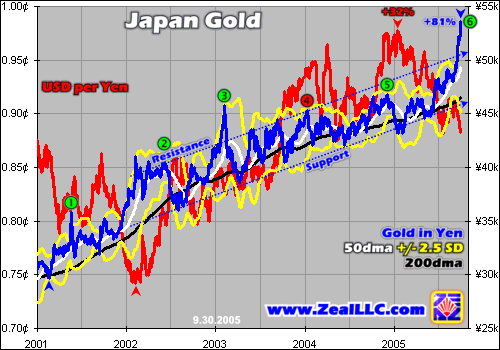
Moving on to Asia, which will
dominate this century economically and politically, Japan gold
has also catapulted up to a dazzling new bull-to-date high. This
is really exciting as the Japanese culture is one of the wealthiest
in the world due to Japan's high savings rates. As Japanese investors
get excited and move more of their vast capital into physical
gold, they can single-handedly drive it higher around the globe.
After the dollar and euro, the yen is the third most important
currency on earth today.
Up 81% bull to date, yen gold
is up a similar magnitude to US dollar gold. Just as gold is
gradually winning more airtime in the US financial media these
days due to its new highs, my Japanese investor friends tell
me gold is also getting more coverage in Japan. If these high
yen gold prices persist as they ought to, more and more Japanese
mainstream investors will start deploying a portion of their
capital into physical gold to ride this bull.
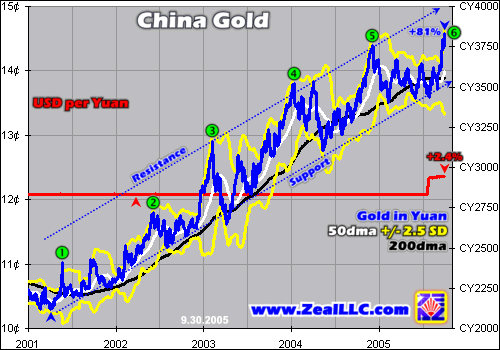
While China has long pegged
its yuan to the US dollar, as the tremendously exciting flat
red line above highlights, it is finally starting a gradual controlled
float of its currency. And since China is universally considered
to be the next global superpower, the price of gold in yuan is
only going to get more important in the coming years. So far,
due to the dollar peg, yuan gold looks exactly like US dollar
gold except for the last few months.
Technically it is interesting
as yuan gold could go quite a bit higher, even over CY4000 per
ounce, before it hits its upper resistance line that has repelled
it several times. The longer these high yuan gold prices persist,
the more Chinese investors will want to buy physical gold. The
Chinese have a long history of capitalism and speculation and
few peoples on earth have a greater cultural affinity for gold.
While the average Chinese citizen isn't wealthy, hundreds of
millions of purchases of small amounts of gold will add up fast
to drive world demand higher.
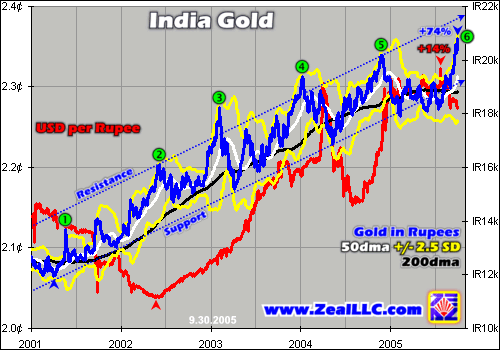
The other Asian giant is India,
which incidentally is the largest market in the world for physical
gold. The Indian culture adores gold and has long used gold as
a key way to store and save wealth after the harvests come in.
Rupee gold is up 74% bull to date and is doing really well since
the rupee really hasn't risen as much as other currencies. Like
yuan gold, rupee gold still has room to rise and remain within
its primary bull-market uptrend.
While Indian gold investors
are more price conscious than most other countries' gold investors,
the demand curve for gold in India is still inverted. The higher
the gold price rises in rupees, the more Indians become convinced
gold is the way to go to preserve and enhance their wealth. Along
with China, India will be the primary driver of physical gold
demand as this bull market continues to blossom over the coming
decade.
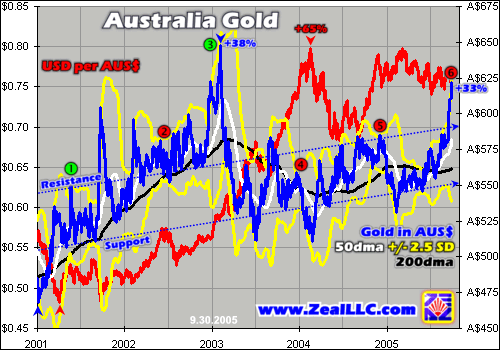
Australia, a major natural-resource-based
economy like Canada, has not witnessed new gold highs for almost
several years now. The massive 65% gain in the Australian dollar
has absorbed much of US dollar gold gains. Back just under A$650
in early 2003 Australia gold was up 38%. Today, even though the
recent breakout didn't carry Australia gold up to new bull-to-date
highs, the metal is still up 33% bull to date.
Nevertheless, a lot of Australian
investors are interested in gold. The Australian contrarians
have been buying gold stocks in recent years both at home and
abroad and reaping major gains. If Australia gold can get up
over A$650 and stay there long enough to convince investors this
gold bull is real, then Australian mainstream investors will
start chasing gold as well. The current secular commodities
bull will benefit Australia immensely.
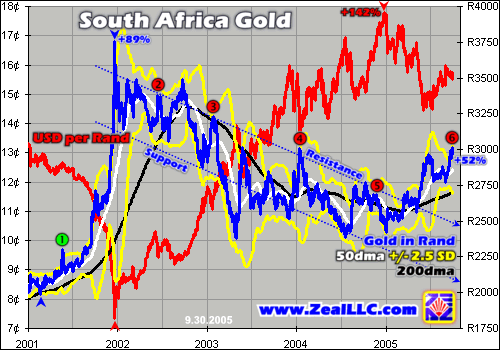
Like South America, Africa
really lacks any impressive currencies. Nevertheless, South Africa
remains one of the most economically important countries on the
continent. And of course this country remains the number one
gold-producing country on the planet, ahead of the US and Australia.
Amazingly, due to the rand
crash in 2001, rand gold has been in a very distinctive downtrend
for years. Gold finally started breaking out this year.
Despite all of this currency
turmoil that saw the rand rocket 142% higher and decimate the
local mining industry since its costs are paid in rand, rand
gold is still up 52% bull to date. This is more than euro gold,
more than Canadian dollar gold, and right in line with UK gold.
Assuming the rand exchange rate is finally stable again, the
rand gold bull market ought to continue ahead unimpeded as global
gold prices rise.
While each of these global
gold charts is certainly interesting when considered in isolation,
I think the most valuable insights emerge when they are considered
together. In nine of these currencies gold has risen rather dramatically
in recent months and six have blasted up to new bull-to-date
highs. These six include the most important currencies in the
world, the US dollar, the euro, the yen, and the yuan. While
gold isn't hitting new highs in all currencies yet, it is certainly
doing it in all the important ones!
These new global gold highs
witnessed around the world strongly buttress the case for Stage
Two, that gold is decoupling from the dollar and taking its bull
market to the next level. This next level is crucial because
gold's demand curve among investors is inverted worldwide. Most
goods witness lower demand the higher their prices go, but gold
and many investments become more sought after the higher their
prices climb.
Thus gold buying in China,
or India, or anywhere that drives up gold demand will push prices
higher around the world. These higher gold prices will in turn
spark interest in more investors and lead to even more capital
bidding on gold, driving it even higher. The higher its price
goes in Stage Two, the more gold demand materializes. Stage Two
is a giant virtuous circle where higher prices drive demand creating
even higher prices and strengthening the cycle.
Investors all over the world
can ride this awesome bull by buying physical gold. Once you
have a physical gold foundation laid in your portfolio, you may
wish to consider adding riskier but potentially vastly more lucrative
gold-based investments like elite gold stocks. The best of the
world's gold producers will go up 10x to 100x+ during this secular
gold bull creating enormous fortunes for prudent contrarians
invested early.
At Zeal we have been actively
riding this gold bull by researching and trading the best of
the world's gold miners since gold bottomed in early 2001. We
have been blessed with countless hundreds of percents in realized
gains so far and the best is almost certainly yet to come.
If you want to join us in our
carefully researched and timed gold-stock trades, please subscribe today
to our acclaimed monthly Zeal
Intelligence newsletter. The ultimate gold-stock profits
to be won before this bull fully runs its course should be mindboggling.
The bottom line is gold is
rising in all major currencies around the world, a telltale Stage
Two hallmark. This is only possible when gold is decoupling from
the dollar, when gold's gains exceed the dollar's losses. While
there are peculiar individual situations where a local gold price
hasn't reached new highs yet, in today's major global currencies
used by several billion potential investors gold is shining brightly.
There is nothing that begets
new gold investment demand faster than rising gold prices, highlighted
by today's global gold highs. No matter which part of the world
you call home, you can invest in this young secular gold bull
and profit tremendously as it continues galloping ahead in the
coming years.
Adam Hamilton, CPA
October 14, 2005
Thoughts, comments, or flames? Fire away at zelotes@zealllc.com. Due to my staggering and perpetually increasing e-mail load, I regret that I am not able to respond to comments personally. I will read all messages though and really appreciate your feedback!
Copyright©2000-2025 Zeal Research All Rights Reserved.
321gold Inc

|